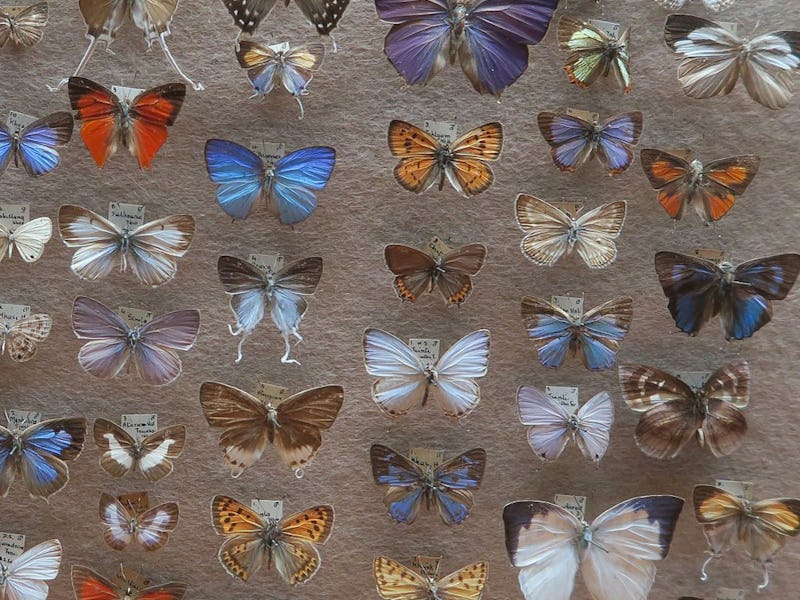Scientists Posit There Are a Trillion Earth Species, Darwin Got Some Stuff Wrong
Sometimes great minds trip on simple questions.

The question of how many species there are on Earth may be science’s most basic yet most elusive query. Historically, because of an unholy scientific trinity of biased techniques, questionable extrapolations, and lack of resources, humans have been pretty terrible at figuring out how many other creatures inhabit this planet with us. But that didn’t stop researchers from Indiana University from giving it the old college try: Based on datasets and universal scaling laws, they predict that Earth may be home to 1 trillion species.
If correct, this estimate means that 99.9 percent of species remain unnamed and undiscovered. In the Proceedings of the National Academy of Sciences, professor Jay Lennon and postdoctoral fellow Kenneth Locey write that their work highlights how much diversity still remains to be described.
“Until now, we haven’t known whether aspects of biodiversity scale with something as simple as the abundance of organisms,” says Locey in a statement. “As it turns out, the relationships are not only simple but powerful, resulting in the estimate of upwards of 1 trillion species.”
This number is far greater than previous predictions — estimates that Locey and Lennon wrote were based on a “dramatically under-sampled” diversity of microorganisms. Before scientists were able to use high-throughput sequencing, they were essentially ignoring the billions of organisms that live in microscopic spaces like soil — focusing instead on larger and more obvious flora and fauna. This conflicted look at species, argues some scientists, is a continuation of a run of historical misunderstandings that have been happening since the days of Charles Darwin’s “Origin of Species.”
While Darwin is now credited with the theory of evolution and the non-constancy of species, his wording on species in his famous text was far from clear — describing species as both “tolerably well-defined objects” and “varieties … linking together any two closely-allied forms.” His imprecise definitions led to a century’s worth of confusion as to what a species really is. In effect, he created a field of study and erected a gigantic hurdle to progress in said field at the same time. Well done, Chuck.
Today — in part due to an effort by the National Science Foundation to fill in the gaps in understanding Earth’s biodiversity by 2020 — taxonomists are going full steam ahead, attempting to discover and categorize the planet’s creatures. But estimates have still varied widely, with some experts suggesting the number could be as low as three million. In a 2014 report, the NSF wrote that there could be 8.7 million eukaryotic species globally, a number that suggested that 86 percent of the existing species on land and 91 percent of the species in the ocean hadn’t been discovered yet. That number — 8.7 million — is still dwarfed by the 1 trillion species estimate announced this week.
Charles Darwin in 1877.
Lennon and Locey’s study (funded in part by the NSF) focuses what has been longer overlooked: microscopic species. Their analysis is the largest ever on microbial data — an examination of 5.6 million microscopic and non-microscopic species from 35,000 locations all over the world, save for Antarctica. Genetic sequencing, write the researchers, has provided an “unprecedentedly large pool of information.”
The data was drawn in part from the extensive collection conducted by the National Institutes of Health’s Human Microbiome Project, the Tara Oceans Expedition, and the Earth Microbiome Project. The team then applied scaling laws — which predicts linear rates of change and have been incorporated into biological predictions since the 19th century — to a lognormal model of biodiversity to predict the scale of all macro- and microorganisms on Earth.
“We suspected that aspects of biodiversity, like the number of species on Earth, would scale with the abundance of individual organisms,” says Lennon. “After analyzing a massive amount of data, we observed simple but powerful trends in how biodiversity changes across scales of abundance.”
While it’s exciting to think that there are a trillion species out there, the likelihood that they’ll all be discovered and catalogued in any of our lifetimes is pretty much nonexistent. Biologist Camilo Mora writes in PLOS Biology:
“Considering current rates of description of eukaryote species in the last 20 years, the average number of new species described per taxonomist’s career (i.e. 24.8 species) and the estimated average cost to describe animal species (US $48,500 per species) and assuming that these values remain constant and are general among taxonomic groups, describing Earth’s remaining species may take as long as 1,200 years and would require 303,000 taxonomists at an approximated cost of US $364 billion.”
And that’s if the species we’re looking for don’t go extinct before we find them. Unlike Pokémon, pretty sure we’re not going to catch them all.